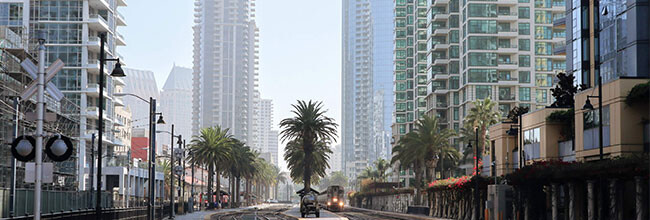Asbestos Lawyer: San Diego
Location:

America’s Finest City and industrial asbestos use grew up at about the same time. Like most other SoCal cities, San Diego started growing in the early 1900s. That was about the same time builders started using asbestos, and the use of asbestos fibers to weave lamp wicks and cremation shrouds impervious to fire were described in ancient times by the Greek geographer Strabo and the Roman naturalist Pliny the Elder, although they did not yet know it was dangerous.
Much later, as the dangers of asbestos became more widely known, many asbestos producers declared bankruptcy. Many other responsible parties, like builders and shipbuilders who used asbestos, are still in business. In other words, no matter what you’ve heard in the media, asbestos exposure victims still have legal options.
!
Speak with your healthcare provider about screening if you may have been exposed to asbestos. Early intervention is everything.
San Diego for Non-San Diegans
Indigenous Kumeyaay people lived in what’s now San Diego as early as 1000 A.D. About 200 people lived in Cosoy, the largest Kumeyaay village. Modern San Diego is a little bigger than that.
For many years, the naval base at San Diego drove the city’s economy. When the end of the Cold War brought military downsizing, the city’s economy expanded into other areas, such as telecom, biotech, and tourism. International trade is a big deal as well. About five million people live in San Diego-Tijuana, making the border crossing the busiest non-Asian portal in the world.
As a footnote, the San Diego International Airport is the world’s busiest single-runway airport. We’re not sure if that’s a good thing or a bad thing.
Asbestos Resources in San Diego
Thankfully, installing asbestos usually is not a problem anymore, although the substance is still technically legal to use in the United States. Asbestos abatement and disposal, however, are very different matters.
Most structures built before about 1980, and most Navy ships built before 1987, contain this toxic mineral. Until these dates, builders extensively used white asbestos, or chrysotile asbestos. This product, which resembles several layers of thick tissue paper, is very common in:
Floor tiles,
Textured paint,
Furnace and stove insulation.
Door gaskets,
Ceiling, wall, and pipe insulation,
Appliances, and
Roofing materials.
Fibrous asbestos sometimes pops up in consumer products as well, especially certain cosmetic products. Some companies use asbestos as a filler. Other times, asbestos gets mixed in with these products. Asbestos and talc are very similar and often found together in the ground. Many companies aren’t especially careful about whether talc or asbestos goes into their products.
Spray asbestos, like the stuff used in the Twin Towers, is much more expensive and therefore not nearly as common. This material is less likely to leak into the air, but if renovation, demolition, or other workers get near it, spray asbestos is every bit as dangerous as chrysotile asbestos.
If these workers find asbestos, they must dispose of it in accordance with some very strict hazardous substance disposal rules.
However, we’re getting ahead of ourselves. Just like the only way to know your legal options is to speak with an asbestos attorney, environmental testing is the only way to know if a structure contains asbestos.
Once again, San Diego’s rules are rather strict. Before any work begins, a licensed asbestos containing material (ACM) contractor must collect and analyze multiple samples. If a test is positive, and the owners want the work to continue, they may seal the asbestos inside the walls or work with an asbestos removal professional. Option two is the best, and most expensive, option.
Do You Qualify For Compensation?
Quickly and easily find out how you were exposed by searching W.A.R.D., the largest asbestos database on the planet.
FREE SEARCH >
San Diego Asbestos Issues
Back in the day, builders knew asbestos was cheap, effective, and dangerous. Unfortunately for victims, they only cared about the first and second qualities.
Shipyards
Frequently, onboard fires cause a lot more casualties on oceangoing vessels than enemy actions. Therefore, shipbuilders were desperate to prevent these fires. Asbestos seemed like the best solution, since as mentioned, it was cheap and effective. As far as DoD bean counters were concerned, that was nearly an unbeatable combination.
Back in the 1940s and 1950s, the San Diego Naval Base employed more than 14,000 people. The base’s heyday was also the asbestos use heyday. Naval workers were also exposed to other dangerous substances, like Volatile Organic Compounds (VOCs), PCBs, dioxins, and Semivolatile Organic Compounds (SVOCs).
Shipboard asbestos was especially common in fire-prone areas, like ammunition dumps and boiler rooms. As mentioned, builders also used lots of asbestos in galleys, common areas, and crew quarters. Millions of microscopic asbestos fibers could escape through a tiny hairline crack in a floor tile.
Schools
Large cities mean large schools, which means lots of kids are exposed to lots of toxic asbestos. The “cheap” quality of asbestos was especially important to school builders. Saving a few dollars on fireproofing and insulation materials was often the difference between making and losing money on a particular job.
Asbestos in schools may be a bigger problem than asbestos anywhere else. According to a study commissioned by former Sen. Barbara Boxer, two-thirds of public schools contained asbestos. More disturbingly, the states that oversaw these schools did little to correct, or even track, the problem.
The 1986 Asbestos Hazard Emergency Response Act includes guidelines for asbestos control and removal in public schools. Unfortunately, AHERA enforcement is spotty at best. A 2018 report found that fewer than 13 percent of education agencies conducted required AHERA inspections.
Although San Diego has made considerable progress in this area, asbestos exposure dangers continue, at both K-12 schools and colleges and universities, like San Diego State University.
Aerospace
Speaking of SDSU, this institution has a comprehensive asbestos inspection and management program, especially at its aerospace facilities. The San Diego naval base also has a large aviation wing.
Similar to ships, fire prevention is a major aerospace priority. Brakes are even a bigger priority. Before 1970, these brake pads were laced with asbestos. Unprotected mechanics and other workers routinely handled these pads. In fact, sometimes mechanic protections included asbestos-laced blankets, gloves, and textiles.
Environmental and Health Hazards
Widely-used chrysotile asbestos is also friable asbestos. This term describes asbestos that crumbles and releases lots of dust. Once this dust gets into the air, it causes a wide range of environmental and health hazards.
Part of the aforementioned asbestos disposal rules includes a Miramar Landfill rule which states that the facility only accepts waste with less than 1 percent asbestos content. Even that tiny level might be too high.
Asbestos dust often settles into drinking water. Most treatment plants cannot remove such toxic particles. There’s also some evidence that environmental asbestos, as opposed to direct asbestos exposure, could cause mesothelioma.
What is mesothelioma? We’re glad you asked. Asbestos exposure is the only known cause of this rare and aggressive form of heart/lung cancer. Overall, cancer survival rates have gone way up since the 1990s. But, since it’s so rare and aggressive, the mesothelioma survival rate is largely unchanged. Doctors usually cannot spot it early. So, by the time doctors find it, they can’t do much about it.
Mesothelioma and other asbestos-related illnesses, liek asbestosis, often have fifty year latency periods. So, if you worked at the San Diego shipyard shortly after its heyday, you might just now show signs of illness.
AsbestosClaims.Law
AsbestosClaims.law is your comprehensive resource for all things asbestos. We hope this information is helpful.
If you have any additional questions or concerns related to asbestos, check out our website and YouTube page for videos, infographics and answers to your questions about asbestos, including health and safety, asbestos testing, removing asbestos from your home and building, and legal information about compensation for asbestos injuries.
And if you believe that you were exposed to asbestos, or have been diagnosed with an asbestos illness, you could be entitled to significant compensation—money you could use to cover the costs of asbestos removal services, pay for medical treatment, and preemptively protect your physical well-being.
All without filing a lawsuit.
If you’d like help with filing a claim, please get in touch by email at [email protected], or call or text us at (833) 4-ASBESTOS (427-2378) or (206) 455-9190. We’ll listen to your story and explain your options. And we never charge for anything unless you receive money in your pocket.